By Jeffrey A. Rendall, Photos By Jeff Janas
Virginia Beach, VA -- Just hearing the names Pete Dye and TPC (Tournament Players Club) together gets your heart pumping. Instantly your mind flashes to the famous seventeenth hole at Dye's TPC Sawgrass -- the dreaded island green -- and your palms sweat at the notion of needing to execute such a pressure golf shot. When you're faced with that kind of challenge, there's no turning back. To borrow a line from Yoda the Jedi Master, it's do or do not -- there is no 'try.'
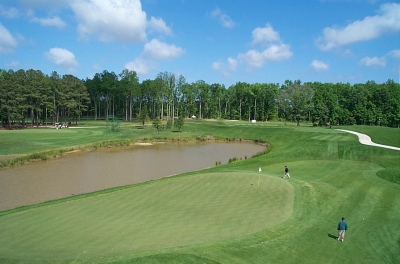 |
| A familiar scene every May -- the 17th hole is always prominent during the Nationwide Tour event. |
It's the same feeling you'll get many times at the TPC of Virginia Beach, because the newest TPC course is also a Pete Dye design with all that goes along with his layouts. I'm not sure the nickname 'Punishment Pete Dye' is entirely warranted, but he certainly gets high marks for scaring the wits out of golfers. Even a brief glance at the scorecard lends itself intimidating -- the course measures 7432 yards from the tips. I can't recall another layout with a '4' coming after a '7.' Wow.
At the same time, you should calm yourself with the knowledge that Dye's courses, though visually frightening at times, also tend to be fair tests of golf -- and that's certainly true of his layout in Virginia Beach, too. There are five sets of tees that'll shave off as much distance as you'd like, and the shorter shots don't just save yardage -- they're easier, by and large, because you'll have greatly improved angles and sight lines. Dye also positions bunkers (or waste areas) throughout the course to help prevent wayward shots from reaching the extremes -- so he'll save you shots in places where you might normally lose them in penalties.
And in the TPC Virginia Beach's case, there's no out-of-bounds to worry about. Most holes have generous fairways, and there're usually a few reasonable driving options presented.
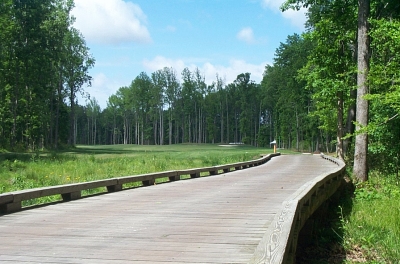 |
| The TPC Virginia Beach has a sampling of many types of holes. Here, you'll need to stay out of the woods. |
There's also an interesting story behind the building of the course. Chris Coleman, the TPC's General Manager/Director of Golf, explains that Virginia Beach was a natural choice for a new TPC course -- because it was a largely underserved market: "The Virginia Beach (and its neighboring cities) area is the largest in the country, population-wise, without a major sports team -- so the people down here are hungry for pro sporting events. The PGA Tour builds these TPC courses with the idea they might host a professional tournament, as we do now with the Buy.com Tour.
"When you also take into account that PGA Commissioner Tim Finchem and player design consultant Curtis Strange are originally from Virginia Beach, there was a lot of positive momentum towards coming here.
"Combine that with Virginia Beach's natural tourist draw, you've got a huge market that up until a few years ago, was largely untapped for golf. Since that time, there've been several new tracks built (or nearly completed) in the area, including our course here. We're fast becoming known as a first-rate golf destination, and the PGA Tour recognized that."
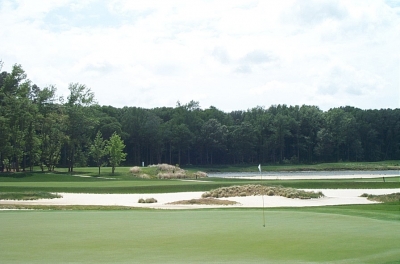 |
| Always prominent on the open holes, the wind can really whip at the TPC. |
To make a long story short, the PGA Tour, which owns and operates all 20 of the TPC properties across the country (eight of which are open to the public and two more are under construction), accepted the City of Virginia Beach's bid to build one here -- and placed the course on a large tract of land in between some of the city's other recreational attractions. Like its neighbor, Heron Ridge, the TPC site was formerly a corn and soybean farm, so it took a great deal of Mr. Dye's imaginative thinking to create something special.
It worked. Was there ever a doubt? Dye worked with the property -- mostly very flat ground with a good stand of hardwoods at the south and east ends--to produce an incredible course with a great deal of variety. Much of the front nine is wide open, very much with a links style flavor. Much of the back nine works through beautifully mature trees. The wind's almost always a factor, and there's little uncertainty the course's length will challenge you.
And don't forget conditioning. We were fortunate to play the day before the TPC was set to host an annual Buy.com Tour event. It goes without saying that the entire course was in pristine condition. I've never seen such thick rough, and the greens were nothing short of outstanding. Coleman explained the putting surfaces are a relatively new strain of bentgrass, L93, which provides incredible consistency without requiring excessive maintenance. The recreational golfer will certainly benefit, along with the touring pros -- the greens will always be in good shape.
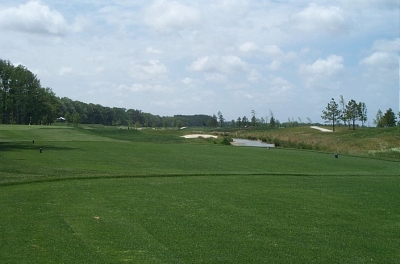 |
| We played shortly before the arrival of the professionals, but one can imagine the rough is this thick and dense most times of year. |
Dye starts out the round with a straightforward 405 yard par four, a huge waste area all down the right side and another to the left of the green. The green looks flat from the viewpoint of your second shot, but once you're on the putting surface you'll note it's got some contour. The green is typical of what you'll find on the course -- subtle breaks and quick surfaces. Nothing tricky or overdone.
The second was one of my favorites. A monster 479 yard par four, it's a dogleg left and the tee shot is the key. Looking from the tee box, the leading edge of the fairway is higher than the trailing edge, so you really have no idea how much room there is out there (actually, there's a lot), so it's a fair choice on how much of the leg you'd like to cut off. Shots too far left (or short) will either catch a waste area that borders the entire left side of the hole, or a lake.
And as is true for all the long par fours on the course, you can run it up. Coleman explains that there are a few trends throughout the course, but there are always the inevitable exceptions. "Generally, you look at the scorecard and see all these long par fours -- but the nice thing about them is they're largely open in front, very receptive to running it up. The shorter par fours require more of a high ball with a quick stop. It's a very fair test, because you'll have several shot options on each hole."
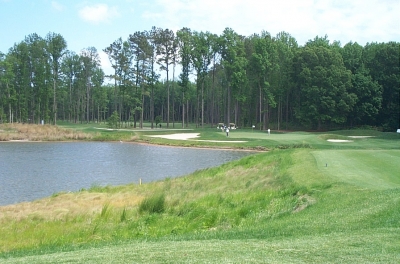 |
| Pete Dye's always been known for creating special par threes. This course is no exception. |
The third hole is a beautiful par three (187 yards). The tee boxes are elevated, allowing for more air under the ball -- and you'll need it to carry a lake. This hole's a great example of how playing different tees changes the difficulty. The back sets are placed to the extreme left, mandating more carry of the lake. The forward sets have less lake to contend with, but the right hand bunkers come more into play. Again, fair challenge.
The seventh is another beautiful par three (177 yards), again with a tee ball over water to the front and right. There is quite a bit of room to bail to the left if need be.
Nine and eighteen share the same lake, and are opposite doglegs. Nine doglegs right, and will give you a lot of the same flavor as eighteen -- long and difficult at 480 yards. Coleman says that the typical wind will help you on both holes, essentially taking the lake out of play on the tee shots -- a right to left wind. The day we played, it was straight in our face, making both holes into virtual par fives.
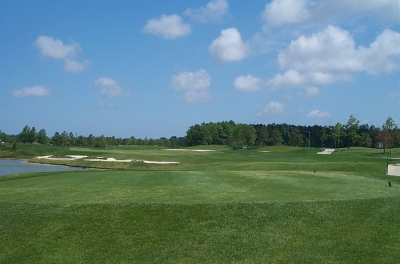 |
| Just when you think it couldn't get any tougher, the 10th tee reminds you who thought up this course. |
Making the turn, the eleventh is a great short par four at 343 yards. It appears very narrow from the tee, and here's where you'll find one of those 'exceptions' to the trends Coleman mentioned above. Naturally, for a short par four, you're thinking iron off the tee and full wedge into the green. Coleman says the best play is actually to hit a driver or three-wood off the tee, because the landing area is much wider on top of a little plateau if you clear a bunker guarding the right side. Local knowledge helps!
Twelve is a great par five -- 615 yards and a dogleg right. Second shots go through a 'chute' to another good sized landing area, but the third shot's still going to be a mid-iron in most cases, because there's a lot of distance to cover--and unless you're very precise, you won't gain enough on your second shot.
The closing sequence is vintage Pete Dye, the par five sixteenth, short par three seventeenth and demanding 498 yard par four eighteenth. The sixteenth is reachable for some long hitters, as it doglegs right from the tee. Most of us humans will take the three shot route -- but even that's a tough one to a green that slopes away from you on the approach shot.
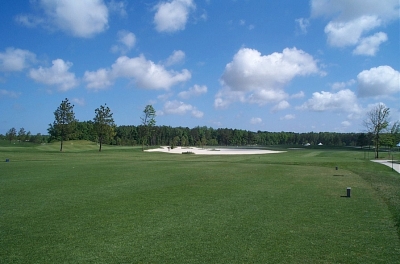 |
| Looks can be deceiving at the TPC -- what appears wide open still requires some precise accuracy. |
Seventeen is a tricky short par three over water. Sound familiar? It's not an island green though -- there's room short and left, but watch out for the bunkers. And the green is very tricky for long-range putts. An easy looking hole, but don't let your guard down.
Eighteen -- 498 yards dogleg left with a lake all down the left side. Draw it too much with the normal prevailing wind, and you're dead. Coleman says it's a good play to aim at the cart path on the right side and let the wind guide the ball to the fairway -- that way, there's no lake trouble. Local knowledge!
In other words, you can play this course. Choose the right tee boxes for your game and you'll be fine. And don't let the names scare you -- the TPC is an excellent course; if you're looking for a professionally manicured, solid test of your golf game, there's none better. So take note if Mr. Dye and a TPC comes to your neck of the woods -- or go visit theirs in Virginia Beach.
Details:
The TPC of Virginia Beach
2500 Tournament Drive
Virginia Beach, VA 23456
Phone: (757) 563-9440
FAX: (757) 563-9442
Website: www.playatpc.com/daily/virginia_beach/index.html
Course Designers: Pete Dye and Curtis Strange
General Manager/Director of Golf: Chris Coleman
| Tees | Yardage/Slope |
| Black | 7432/142 |
| Gold | 6974/138 |
| Blue | 6535/129 |
| White | 6056/125 |
| Red | 5314/114 |
Rates:
Mon-Sun, $115. Discounts for local residents.
Significant discounts available through 'Stay and Play' package deals with most hotels. Off season rates as low as $75.
Walking is an option; some power caddies for rent.
| Related Links | Comments on this article? | |
|
Maryland National Golf Club Hollow Creek Golf Club Rocky Gap Resort PB Dye Golf Club in Ijamsville Whiskey Creek Golf Club |
E-mail Jeff Rendall, Editor: jrendall@golftheunitedstates.com |












